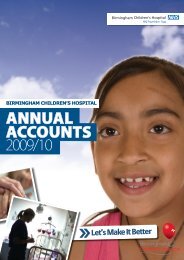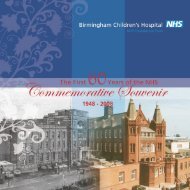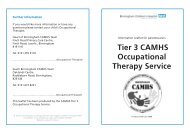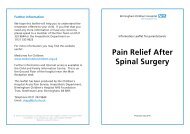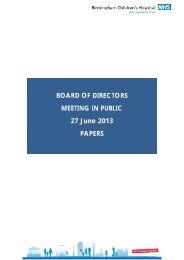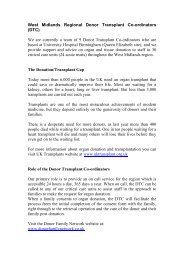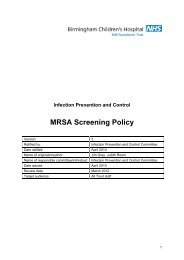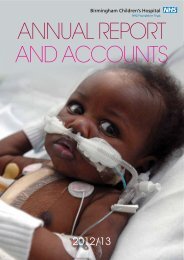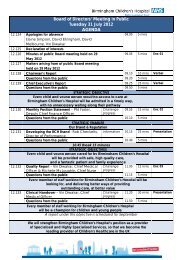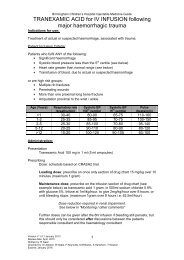Your child's general anaesthetic - Birmingham Children's Hospital
Your child's general anaesthetic - Birmingham Children's Hospital
Your child's general anaesthetic - Birmingham Children's Hospital
Create successful ePaper yourself
Turn your PDF publications into a flip-book with our unique Google optimized e-Paper software.
<strong>Your</strong> child’s <strong>general</strong> <strong>anaesthetic</strong><strong>Your</strong> child’s <strong>general</strong> <strong>anaesthetic</strong>This booklet explains what to expect when your childcomes into hospital to have an operation or investigationunder <strong>general</strong> anaesthesia.It is part of a series about <strong>anaesthetic</strong>s and related topicswritten by a partnership of patient representatives, parentsand anaesthetists. You can find more information in otherleaflets in the series.You can get these leaflets, and large print copies, fromwww.your<strong>anaesthetic</strong>.info. They may also be availablefrom the <strong>anaesthetic</strong> department in your hospital.The series will include the following:●●●●●●●●●●Anaesthesia explainedYou and your <strong>anaesthetic</strong> (a summary of the above)Having a spinal <strong>anaesthetic</strong>Epidurals for pain relief after surgeryHeadache after an epidural or spinal <strong>anaesthetic</strong>Dental work and <strong>general</strong> anaesthesiaHaving an eye operation under local <strong>anaesthetic</strong><strong>Your</strong> tonsillectomy<strong>Your</strong> <strong>anaesthetic</strong> for aortic surgeryAnaesthetic choices for hip or knee replacementThroughout this booklet we use these symbolsTo highlight your options or choices.To highlight where you may want to take particular action.To point you to more information.What is anaesthesia?The word ‘anaesthesia’ means ‘loss of sensation’.A <strong>general</strong> <strong>anaesthetic</strong> ensures that your child is unconsciousand free of pain during a test (investigation) or operation.●●●General anaesthesia is a state of controlledunconsciousness and freedom from pain.Anaesthetics are the drugs (gases and injections) thatare used to induce and maintain anaesthesia.Anaesthetists are specialist doctors who areresponsible for the wellbeing of your child throughoutsurgery.Anaesthetists are also closely involved with your child’spain relief after surgery.ChoiceIt is often possible for you and your child to choose howthe <strong>anaesthetic</strong> and other medicines are given. Sometimesthere are medical reasons why things have to be done in acertain way – these will be explained to you.Nothing will happen unless you understandand agree with what has been planned.<strong>Your</strong> wishes and those of your child are very important.We want to work with you to provide the best possiblecare for your child and family.Anaesthesia, anaesthetists and Choice3
<strong>Your</strong> child’s <strong>general</strong> <strong>anaesthetic</strong><strong>Your</strong> child’s <strong>general</strong> <strong>anaesthetic</strong>PreparationPreparationThere are many things that you can do to prepare yourchild for coming into hospital.All children (except infants too young to understand)should be told:●●that they are going into hospitalthat they will be having an operation orinvestigation● some basic information about what will happen tothem when they are in hospital.Everything should be explained to your child in a way thathe/she can understand. Many hospitals have play staff whocan give explanations and encourage discussion through play.Timing●●●Children between 2 and 3 years of age should betold 2 – 3 days before and again on the day ofadmission.Children between 4 and 7 years of age should betold 4 – 7 days before the day of admission.Older children will usually be involved in makingdecisions about the operation or investigation anddiscussion can take place a few weeks before theday of admission.Many hospitals have times when you and your child can visitthe ward and operating theatres before the day of admission.Some ideas of what to say…●●●Explain that the operation or investigation will helpyour child to get better.Use simple words your child understands.Do encourage your child to talk about the operationand ask questions. Books, games and stories can help.● Tell your child about timing – when he or she willhave the operation or investigation and how long theirstay in hospital will be.If your child will be staying in hospital overnight, let him orher know if you will be able to stay too. Some hospitalsprovide accommodation for parents away from the ward,others provide a folding bed next to your child’s bed.If it is not possible for you to stay withyour child, it is important that youexplain to him or her when you willbe able to visit.<strong>Your</strong> child can help pack his orher own bag and decidewhich nightclothes and toysto bring.Please let us knowin advance any specialrequirements your child has and wewill do whatever we can to help.Please phone the hospital if your child develops a severecough or cold, or has contact with chicken pox shortlybefore the day of the operation or investigationPreparation45
<strong>Your</strong> child’s <strong>general</strong> <strong>anaesthetic</strong><strong>Your</strong> child’s <strong>general</strong> <strong>anaesthetic</strong>On the day of admissionOn the day of admissionA pre-operative visitAn anaesthetist should visit you on the ward before theprocedure to discuss your child’s <strong>anaesthetic</strong>.The anaesthetist needs to find out about your child’s<strong>general</strong> health, previous experiences of anaesthesia, anymedicines your child is taking and any allergies he or shemight have.This is a good time to talk about any previous experiencesyour child has had with injections or hospitals, or anyparticular concerns you have about this hospital visit.You may find it helpful to make a list of questionsyou want to ask.For practical reasons, the anaesthetist who comes to seeyou on the ward may not always be the same one whogives your child’s <strong>anaesthetic</strong>, but the information you givethem will be passed on.Delaying the operation or investigationOccasionally the anaesthetist may learn something aboutyour child that means it would be safer not to do theprocedure on that day.This could happen if your child has a bad cold, has a rashor has eaten food too recently.Nothing to eat and drink – fasting(‘Nil by mouth’)The hospital should give you clear instructions aboutfasting. It is important for your child to follow these.If there is food or liquid in your child’s stomach during the<strong>anaesthetic</strong>, it could come up into the back of the throatand damage his or her lungs.These are the latest times that you should give yourchild anything to eat or drink:●●●6 hours before your child can have a light meal,a glass of milk or a fizzy drink.Bottle fed babies can have formula feed.4 hours before babies can have breast milk.2 hours before all children and babies can have a drinkof water or dilute cordial but not a fizzy drink.On the day of admission67
<strong>Your</strong> child’s <strong>general</strong> <strong>anaesthetic</strong><strong>Your</strong> child’s <strong>general</strong> <strong>anaesthetic</strong>PremedicationGoing to theatrePremedication (a premed) is the name for drugs which aresometimes given before an <strong>anaesthetic</strong>, although todaythey are given less often.Some premeds help your child to relax, and some arerelated to the kind of surgery he or she will be having.Not every child needs a premed. Depending on the kind ofsurgery and your child’s condition, you will often be able tohelp decide, with the anaesthetist, whether your childneeds a premed or not.If your child does need a premed, this will usually be givenas a liquid. Occasionally an injection is essential.Premeds are given some time before the <strong>anaesthetic</strong>.They may make your child drowsier afterwards and if youplan to take him or her home on the same day,this may be delayed.<strong>Your</strong> child may be able to wear his or her own clothes tothe operating theatre, but if not most hospitals providecolourful gowns to wear.<strong>Your</strong> child will be able to keep underwear on.<strong>Your</strong> child may travel to the <strong>anaesthetic</strong> room in a bed, ona trolley, walking or being carried. Some hospitals have atoy vehicle that children can drive to the <strong>anaesthetic</strong> room.On the day of admissionThe drugs used can be:●●●●Sedatives to ease your child’s anxietyPain relieving drugs such as paracetamol that canhelp at the end of the procedureMedications to protect your child from side effectsof the <strong>anaesthetic</strong> (for example, nausea)An extra dose of treatment for illnesses like asthmaAnaesthetic room – the room next to the operatingtheatre where <strong>anaesthetic</strong>s are usually administered.Operating theatre – the room where surgery is performed.If your child is very small, or is having certain kinds ofsurgery, it may be safer to give the <strong>anaesthetic</strong> in theoperating theatre rather than in the <strong>anaesthetic</strong> room.Recovery room – a place near the operating theatrewhere children go after surgery until the effects of the<strong>anaesthetic</strong> drugs wear off.In the <strong>anaesthetic</strong> roomA nurse from the ward will accompany you to the<strong>anaesthetic</strong> room. <strong>Your</strong> child will be able to take a toy orcomforter.If you wish, you will usually be welcome to stay with yourchild until he or she is unconscious. However, there are afew circumstances when this will not be possible. It mightbe possible to give the <strong>anaesthetic</strong> while your child is sittingon your lap. <strong>Your</strong> child can either have an <strong>anaesthetic</strong> gasto breathe or an injection through a cannula (see next page).On the day of admission89
<strong>Your</strong> child’s <strong>general</strong> <strong>anaesthetic</strong><strong>Your</strong> child’s <strong>general</strong> <strong>anaesthetic</strong>Some children prefer gas and some prefer injections.If both methods are safe for your child, you may be able tochoose which is used.What happens next?<strong>Your</strong> child will be taken into the operating theatre tohave the operation or investigation.The anaesthetist will monitor your child’s blood pressure,pulse, temperature and breathing closely throughout theprocedure, ensuring that he or she is safe and fullyunconscious. Anaesthetic gases and/or drugs given into avein will be used to keep your child anaesthetised.On the day of admissionAnaesthetic gases smellsimilar to felt-tip pens.The anaesthetist <strong>general</strong>ly cups a hand over the child’snose and mouth or uses a face-mask to give the<strong>anaesthetic</strong> gas.If the <strong>anaesthetic</strong> is given by gas, it will take a littlewhile for your child to be anaesthetised. He or she maybecome restless as the gases take effect.If an injection is used, your child will normally becomeunconscious very quickly indeed.Some parents may find this frightening.‘Magic Cream’ is local <strong>anaesthetic</strong> cream that can be puton the hand or arm before injections so that they do nothurt. It works well for 9 out of 10 children.This cream is also called EMLA or Ametop.A cannula is a thin plastic tube that is placed under theskin, usually on the back of the hand. A needle is used toput the cannula in, but is then immediately removed.A cannula can be left in place for hours or days so thatdrugs and fluids can be given without the need for furtherinjections. Sometimes blood samples can be taken througha cannula.After surgeryMost children go to a recovery room.Each child is cared for by a specialist nurse until he or she hasregained consciousness and is comfortable enough to returnto the ward. In most hospitals a parent or guardian can bewith their child in the recovery room as he or she wakes up.Some children may need to go to the Intensive Care Unitafter their operation. This will be discussed with youbeforehand if it is planned.Pain reliefPain relieving drugs are given during the <strong>anaesthetic</strong> toensure that your child is as comfortable as possible aftersurgery. The type and strength of pain relief given willdepend on the procedure.You will have a chance to discuss and help plan the kind ofpain relief (analgesia) your child will get after their operation.Some hospitals have leaflets giving more detailedinformation about the methods of pain relief available.Pain relief1011
<strong>Your</strong> child’s <strong>general</strong> <strong>anaesthetic</strong><strong>Your</strong> child’s <strong>general</strong> <strong>anaesthetic</strong>Ways of giving pain relief●Syrups and tablets – just like at home.● Melts – medicines that ‘melt in your mouth’ –these are especially suitable for older children.●●Suppositories – some pain relieving medicines likeparacetamol can be given rectally (into the bottom). Theseare often given while your child is anaesthetised and last forseveral hours. Suppositories are very helpful when childrencannot take medicines by mouth or are feeling sick.Local <strong>anaesthetic</strong>s – these are injected near the nervesaround the operation site to numb the area. The injectionsare given while your child is anaesthetised and the painrelief lasts for several hours.Going homeMost children have their investigations or operationscarried out as ‘day stay’ patients and go home on the sameday. They may experience some pain or discomfort on thefirst day or so. Usually the hospital will give you painrelieving medication to take home with you and explainhow this should be taken.Occasionally children may feel sick after they have lefthospital, or even vomit. This sometimes happens in the caron the way home.Pain relief●Strong pain relieving drugs – such as morphine can begiven in many different ways.Some common terms used with medicines●●●●●IV – intravenous – when drugs are given into a veinthrough a cannula.IM – intramuscular – when drugs are given by injectioninto the muscles of the bottom or upper arm.S/C – subcutaneous – when drugs are given just underthe skin, either as a ‘one off’ or through a cannula.Infusion – when drugs are administered continuously,usually by a special pump.PCA – Patient Controlled Analgesia – an infusion ofpain relieving drugs controlled by a pump with a buttonwhich your child can push when extra doses are needed.Sometimes children do not sleep well after a stay in hospital.Their behaviour might be a little bit more clingy or difficultthan before. This is a normal reaction to a stay in hospital,and will usually return to normal within 3 – 4 weeks.If you have any concerns about your child when you gethome you should contact the hospital using the telephonenumber provided.Going home●Epidural – an injection or infusion of local <strong>anaesthetic</strong>around the spine – used after major surgery.●Caudal – an injection of local <strong>anaesthetic</strong> near the nervesas they leave the spine, similar to an epidural.1213
<strong>Your</strong> child’s <strong>general</strong> <strong>anaesthetic</strong><strong>Your</strong> child’s <strong>general</strong> <strong>anaesthetic</strong>Side effects and complicationsUseful organisationsSide effects and complicationsIn modern anaesthesia, serious problems are uncommon.Risk cannot be removed completely, but modernequipment, training and drugs have made it a much saferprocedure in recent years.Most children recover quickly and are soon back to normalafter their operation and <strong>anaesthetic</strong>. Some children maysuffer side effects like sickness or a sore throat. Theseusually last only a short time and there are medicinesavailable to treat them if necessary.The exact likelihood of complications depends on yourchild’s medical condition and on the nature of the surgeryand anaesthesia your child needs. The anaesthetist candiscuss this with you in detail at the pre-operative visit.For a child in good health having minor surgery:●●1 child in 10 (like one person in a large family) mightexperience a headache, sore throat, sickness or dizziness.1 child in 100 (like one person in a street) might be mildlyallergic to one of the drugs that has been given.● 1 child in 20,000 (like one person in a small town) mightdevelop a serious reaction (allergy) to the <strong>anaesthetic</strong>Throughout the whole of life, an individual is at least 100times more likely to suffer serious injury or death in a roadtraffic accident than as a result of anaesthesia.Action for Sick ChildrenC/o National Children’s Bureau8 Wakley Street www.actionforsickchildren.orgLondon EC1V 7QE Phone: 020 7843 6444This is a children’s healthcare charity, specially formed to ensurethat sick children always receive the highest standard of care.They have a series of information leaflets specifically to helpparents cope with, and prepare for, different aspects of children’shealthcare.Association of Anaesthetists of Great Britain andIreland21 Portland Place www.aagbi.orgLondon WC1B 1PYE-mail: info@aagbi.orgPhone: 020 7631 1650 Fax: 020 7631 4352This organisation works to promote the development ofanaesthesia and the welfare of anaesthetists and their patients inGreat Britain and Ireland.Royal College of Anaesthetists48-49 Russell Square www.rcoa.ac.ukLondon WC1B 4JY.E-mail: info@rcoa.ac.ukPhone: 020 7908 7300 Fax: 020 7813 1876This organisation is responsible for standards in anaesthesia,critical care and pain management throughout the UK.Useful organisations1415
Questions you may like toask the anaesthetistQ Who will give my child’s<strong>anaesthetic</strong>?Q What type of <strong>anaesthetic</strong>do you recommend?Q Have you often used thistype of <strong>anaesthetic</strong>?Q What are the risks of thistype of <strong>anaesthetic</strong>?Q Does my child have anyspecial risks?Q How will my child feelafterwards?<strong>Your</strong> child’s<strong>general</strong><strong>anaesthetic</strong>Tell us what you thinkWe welcome any suggestions toimprove this booklet.You should send these to:The Patient Information Unit,48 Russell Square,London WC1B 4JYemail: admin@your<strong>anaesthetic</strong>.infoEdition dateThe Royal College ofAnaesthetistsThe Association ofAnaesthetists ofGreat Britain andIrelandInformation forparents & guardiansof children



